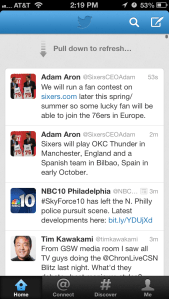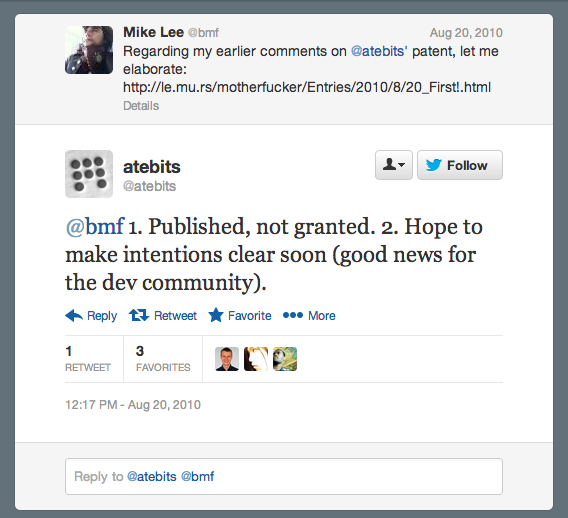Editor’s note: Leonid (“Lenny”) Kravets is a patent attorney at Panitch, Schwarze, Belisario and Nadel, LLP in Philadelphia, PA. Lenny focuses his practice on patent prosecution and intellectual property transactions in computer-related technology areas. He specializes in developing IP strategy for young technology companies and blogs on this topic at StartupsIP. Follow Lenny on Twitter @lkravets.
Over the past few years there has been a lot written by me and others about Twitter’s acquisition of the pull-down-to-refresh patent application with its purchase of Tweetie. According to Public PAIR (search for application number 2010-0199180), the USPTO has completed its examination of the patent application, and found allowable claims. Twitter has decided to take the allowable claims, which resulted in an allowance of the application being issued by the USPTO.
On February 28, Twitter paid the patent issue fees, meaning that the USPTO will grant and issue the patent (barring something out of the ordinary occurring) in the coming weeks. According to the USPTO assignment database, this will be the first patent assigned to Twitter, though it may have other patents and/or patent applications under different names.
The Allowed Claims
Three independent claims (10, 20 and 23) have been allowed in the application. The actual allowed independent claims are reproduced at the bottom of this post. In allowing the application, the examiner provided comments regarding reasons for allowance. The examiner states that he could not “locate a prior art that teaches a pull-to-refresh feature or ‘scrollable refresh trigger’ as used in independent claims 10, 20 and 23.”
Therefore, based on the lack of prior art, Twitter was able to obtain fairly broad protection. For all intents and purposes, claims 10 and 23 are identical in scope, and are significantly broader than claim 20. Claim 20 is more specific to a particular implementation of scroll-to-refresh than claims 10 and 23.
 In order to fall under claims 10 and 23, a mobile application must:
In order to fall under claims 10 and 23, a mobile application must:
1) Display a list of scrollable items (e.g., tweets, e-mails, blog posts, etc.).
2) Receive a scroll command input.
3) Display a “scrollable refresh trigger” based on the scroll command (e.g., the text or graphic that appears when you scroll to the top of the list).
4) Refresh the scrollable list when it is determined that the scrollable refresh trigger has been activated.
In order to fall under claim 20, a mobile app must:
1) Display a chronologically arranged list of content items.
2) Receive touch-based scroll user input.
3) Display a scrollable refresh trigger configured to scroll with the scrollable list of content items.
4) Determine that the scrollable refresh trigger is fully displayed, and provide an instruction associated with activating the scrollable refresh trigger.
5) Refresh the content list if the scroll command was completed while the scrollable refresh trigger was fully displayed. (Note: This appears to be the way Twitter’s app utilizes pull-down-to-refresh).
6) Automatically scroll the scrollable list of content items such that the scrollable refresh trigger is not displayed.
So What Now?
When word first came out about the pull-down-to-refresh patent application, the inventor, Loren Brichter, tweeted that it would be a good thing for the mobile community:
Twitter acquired the pull-down-to-refresh patent application from Tweetie in 2010. Since that time, Twitter came out with its Innovator’s Patent Agreement (IPA). According to Ben Lee, Twitter’s head of litigation and intellectual property, “a patent assigned under the IPA can still be used to defend the company against…legal threats. But the company is not empowered by itself under the IPA to start a patent war or try to shut out a competitor.”
However, the assignment for this application from Brichter to Tweetie, and thereafter to Twitter was signed and recorded with the USPTO in 2010, presumably long before Twitter’s creation of the IPA. Therefore, it is unclear whether Twitter is bound by the IPA for this particular patent application and how Twitter will use its new patent. While I don’t expect Twitter to suddenly aggressively assert its newfound rights, I am sure that both Google and Apple, as well as many other third-party mobile app developers, will be closely monitoring this one.
Actual Allowed Independent Claims
The allowed independent claims of the application, which should issue in the patent are reproduced below:
10. A method, comprising:
- displaying a scrollable list of content items;
- receiving input associated with a scroll command;
- based on the scroll command, displaying a scrollable refresh trigger; and
- in response to determining, based on the scroll command, that the scrollable refresh trigger has been activated, refreshing the scrollable list of content items.
20. A non-transitory computer-readable medium comprising computer-executable instructions stored thereon that, when executed by a processor, cause the processor to:
- display a scrollable list of content items, the scrollable list of content items including a plurality of discrete content items arranged chronologically;
- receive input associated with a scroll command, the input representing touch-based user input;
- based on the scroll command, display a scrollable refresh trigger configured to scroll with the scrollable list of content items;
- in response to determining that the scrollable refresh trigger is fully displayed, provide an instruction associated with activating the scrollable refresh trigger;
- in response to determining that the scroll command was completed while the scrollable refresh trigger was fully displayed, refresh the scrollable list of content items; and
- in response to determining that the scrollable list of content items has been refreshed, automatically scroll the scrollable list of content items such that the scrollable refresh trigger is not displayed.
23. A non-transitory computer-readable medium, comprising instructions that when executed cause a processor to:
- display a scrollable list of content items;
- receive input associated with a scroll command;
- display a scrollable refresh trigger based on the scroll command; and
- refresh the scrollable list of content items in response to a determination, based on the scroll command, that the scrollable refresh trigger has been activated.

